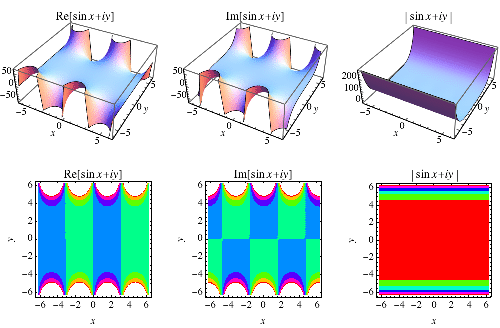The sine function
is one of the basic functions encountered in trigonometry
(the others being the cosecant, cosine,
cotangent, secant, and tangent). Let
be an angle measured counterclockwise
from the x-axis along an arc
of the unit circle. Then
is the vertical coordinate of the arc endpoint, as
illustrated in the left figure above.
The common schoolbook definition of the sine of an angle in a right triangle
(which is equivalent to the definition just given) is as the ratio of the lengths
of the side of the triangle opposite the angle and the hypotenuse,
i.e.,
|
(1)
|
A convenient mnemonic for remembering the definition of the sine, as well as the cosine and tangent, is SOHCAHTOA (sine equals opposite over hypotenuse, cosine equals adjacent over hypotenuse, tangent equals opposite over adjacent).
As a result of its definition, the sine function is periodic with period . By the Pythagorean theorem,
also obeys the identity
|
(2)
|
 |
The definition of the sine function can be extended to complex arguments , illustrated above, using the definition
|
(3)
| |||
|
(4)
|
where e is the base of the natural logarithm and i is the imaginary number. Sine is an entire function and is implemented in the Wolfram Language as Sin[z].
A related function known as the hyperbolic sine is similarly defined,
|
(5)
|
The sine function can be defined analytically by the infinite sum
 |
(6)
|
It is also given by the imaginary part of the complex exponential
|
(7)
|
The multiplicative inverse of the sine function is the cosecant, defined as
|
(8)
|
The sine function is also given by the limit
 |
(9)
|
where is the Möbius
function and
is the fractional part (M. Trott).
The derivative of is
|
(10)
|
and its indefinite integral is
|
(11)
|
where is a constant
of integration.
Using the results from the exponential sum formulas
 | ![I[sum_(n=0)^(N)e^(inx)]](/images/equations/Sine/Inline20.svg) |
(12)
| |
|
(13)
| |||
|
(14)
| |||
![(sin(1/2(N+1)x))/(sin(1/2x))I[e^(iNx/2)]](/images/equations/Sine/Inline29.svg) |
(15)
| ||
![(sin(1/2Nx)sin[1/2(N+1)x])/(sin(1/2x)).](/images/equations/Sine/Inline32.svg) |
(16)
|
Similarly,
![I[sum_(n=0)^(infty)p^ne^(inx)]](/images/equations/Sine/Inline35.svg) |
(17)
| ||
|
(18)
| |||
|
(19)
|
The sum of can also be done in closed form,
![sum_(k=0)^Nsin^2(kx)=1/4{1+2N-cscxsin[x(1+2N)]}.](/images/equations/Sine/NumberedEquation10.svg) |
(20)
|
A related sum identity is given by
 |
(21)
|
(T. Drane, pers. comm., Apr. 19, 2006).
Product identities include
 |
(22)
|
which is more commonly written as an identity for the sinc function or in the form
 |
(23)
|
(Edwards 2001, pp. 18 and 47; Borwein et al. 2004, p. 5). Another product formula is
 |
(24)
|
(T. Drane, pers. comm., Apr. 19, 2006).
The sine function obeys the identity
|
(25)
|
and the multiple-angle formula
![sin(nx)=sum_(k=0)^n(n; k)cos^kxsin^(n-k)xsin[1/2(n-k)pi],](/images/equations/Sine/NumberedEquation16.svg) |
(26)
|
where is a binomial
coefficient. It is related to
via
 |
(27)
|
(Trott 2006, p. 39).
A curious identity is given by
 |
(28)
|
for all and
(Calogero 1999; Beylkin and Mohlenkamp 2002;
Trott 2005, pp. 5-6).
Cvijović and Klinowski (1995) show that the sum
 |
(29)
|
has closed form for ,
|
(30)
|
where is an Euler
polynomial.
A continued fraction representation of is
 |
(31)
|
(Olds 1963, p. 138).
The value of
is irrational for all integers
except 2, 4, and 12, for which
,
,
and
, respectively, a result
that is essentially known as Niven's theorem.
The Fourier transform of is given by
|
(32)
| |||
|
(33)
|
A definite integral involving is given by
|
(34)
|
for where
is the gamma function
(R. Mabry, pers. comm., Dec. 15, 2005; T. Drane, pers. comm., Apr. 21,
2006).